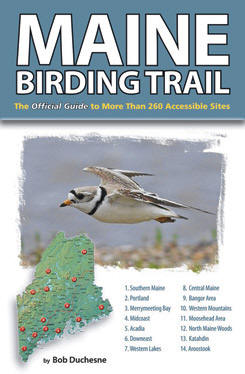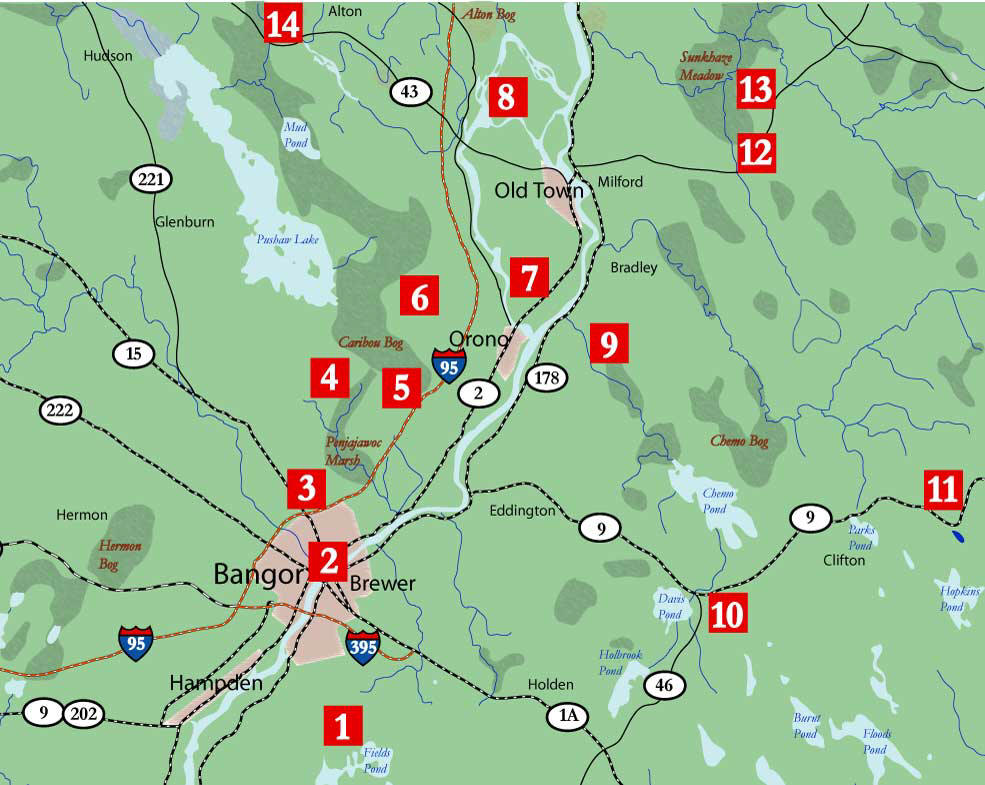The following sites are located in and around Bangor. The descriptions are excerpted from The Official Guide to the Maine Birding Trail, with over 260 sites and 100 maps around the state. The Guide is available through Down East Books on-line at www.downeast.com and at local bookstores.

1. Fields Pond Audubon Center is on Fields Pond Road at the Holden-Orrington town line east of Brewer. The sanctuary encompasses 190 acres of fields, wetlands, forest, lakeshore frontage, plus a 22-acre island. The nearby Sedgeunkedunk Stream Marsh is one of the best places in the area for early spring waterfowl, many of which remain to nest. Continue driving south along Fields Pond Road to reach the marsh. The center also contains a small birding store with books, optics, and supplies. The center is open Wednesday through Sunday (and other times when staffed.) The property is open to visitors dawn to dusk, seven days a week.
Directions: from I-95, take exit 182 to I-395 in the direction of Brewer. Proceed over the Penobscot River, and then take the Parkway South exit from I-395. Turn left from the exit, continue on Parkway South to a four-way junction. Turn left on Elm Street, which becomes Wiswell Road in about a mile. Continue on Wiswell Road to Fields Pond Road, turn left and follow to the center on the left.
2. Penobscot River, along its entire length, can hold many surprises. During the warmer months, Double-crested Cormorants are everywhere. In winter months, gulls congregating on the ice flows sometimes include an Iceland or Glaucous Gull. Common Mergansers and Common Goldeneyes are found wherever the river is free of ice from Bangor to Old Town. Barrow’s Goldeneyes move into the river in the cold months. Bald Eagle populations have rebounded and they can now be expected along the entire river at any time of year. In summer the dam in Old Town is entertaining because of the abundant swallows that cavort over the whitewater. Tree, Barn, Cliff, and Rough-winged Swallows can all be present.
3. Essex Woods is a Bangor city property that surrounds a productive wetland. Warbling Vireos, Yellow Warblers, and American Redstarts are abundant. Baltimore Orioles, Scarlet Tanagers, and Chestnut-sided Warblers are common. Blue-winged Teal, Pied-billed Grebes, American Bitterns, and Green Herons are likely breeders, and it should be easy to find Mallards and American Black Ducks. The trail begins atop Essex Street Hill and follows a paved path 0.25 miles downhill to where it splits in a T intersection.
Directions: From I-95, turn off onto Broadway in Bangor, go right off the ramp, and turn right immediately onto Alden Street. A quick series of turns will follow from Alden to N. French to E. Broadway to Lancaster Ave, which will end on Essex Street nearly opposite Watchmaker Street. Essex Woods is at the end of Watchmaker.
4. The West Penjajawoc Grasslands are maintained as bird habitat by the Bangor Land Trust. This 13 acre parcel is overrun with ground-nesting Bobolinks and Savannah Sparrows, so it is important to stay on the mowed path. Tree and Barn Swallows are common. Because of the expansive field of view, Common Ravens and raptors are often seen along the tree line – primarily Broad-winged Hawks and Northern Harriers, but occasionally Sharp-shinned and Cooper’s Hawks.
Directions: From the Stillwater end of Essex Street, drive approximately three miles, passing Chestnut Trail, and turning right onto Fox Hollow Lane. Stay on Fox Hollow Lane until the cul-de-sac parking area at the end. A kiosk contains maps and information.
5. Bangor City Forest and the Orono Bog Boardwalk are included in a 680-acre forest tract owned by the city of Bangor. The property features about nine miles of hiking and biking trails and four miles of access roads. It offers a close-in tract of mature woods with a variety of warblers, thrushes and other woodland birds, all of which are easy to see because of the width of the trails. The Orono Bog Boardwalk was constructed in 2003. This spectacular 4200-foot long boardwalk loops through peat and bog habitats, providing views of specialty breeders such as Lincoln’s Sparrow and Palm Warbler. The boardwalk is wheelchair accessible, and operates from May through November.
Directions: From the end of Hogan Road north of the Bangor Mall, turn right onto Stillwater Avenue, then travel about 1.3 miles to Tripp Drive. (Look for see small signs to the Bangor City Forest and the Bog Boardwalk.) Drive into the Bangor City Forest parking lot at the end of the road, park, and follow the East Trail about 0.25 miles to the boardwalk.
6.Newman Hill Preserve is also known locally as the Taylor Bait Farm, although it is no longer commercially active. Its shallow ponds have a local reputation for attracting waterfowl in the spring and shorebirds in the fall. While part of the preserve is protected by easements by the Orono Land Trust, much of the site is private property and must be respected. Stay on roads.
Directions: From the Bangor Mall, go north on Stillwater Avenue to Forest Avenue. Turn left, proceed 1.4 miles, and turn right onto the Taylor Road. Park only where designated along the first pond and stay on marked trails and roads. The best birding is from the road itself so there is no need to trespass on private property.
7. The University of Maine campus is dotted with special and unusual plantings, from ornamental gardens to ivy-covered walls. In winter, it is one of the most likely spots to find Bohemian Waxwings. In irruptive years, Pine Grosbeaks flock to the Littlefield Ornamental Garden and its crab-apple grove. During the summer, Cliff Swallows have traditionally built their mud nests on the Maine Center for the Arts and the nearby Donald Corbett Center building. House Finches are regular at campus feeders. Common Nighthawks are often present at dusk and probably nest on campus.
8. University (Demerritt) Forest is similar to the Bangor City Forest. It is a summer residence for many breeding warblers, and at least four thrushes and five woodpeckers. It is mixed deciduous and conifer with large stands of mature woods. It is an experimental forest with large monocultural tracts of thinned trees that offer uniquely clear birding views. The trails are frequented by bikers, hikers, dog-walkers, and cross-country skiers, but the shared use seldom detracts from the birding. In the winter, it can be a good place for crossbills.
Directions: Take exit 193 off I-95 and proceed one mile north along Stillwater Avenue toward Old Town. At the McDonald’s Restaurant, a right turn leads to the campus. A left onto College Avenue Extension leads to the University Forest, 1.1 miles ahead. Look for the gated gravel road on the right, with a parking lot opposite the gate on the left.
9. Leonard’s Mills is a restored logging mill and pioneer settlement. The mile-long access road is a predictable warbler environment in May and June, with a variety of habitats over a conveniently short trek. The museum complex is interesting, and there is a nature trail on the far side of the grounds. There is a gated road beyond the parking lot that leads toward Chemo Pond.
Directions: Located on Route 178 in Bradley, halfway between Brewer and Milford. Watch for the sign. Park at either end of the access road. There is room for several vehicles at the beginning of the road, and a large parking area at the end.
10. Floods Pond Road on the Eddington/Clifton line on Route 9 is ideal for birding while biking, rollerblading, walking the dog, or even pushing a baby stroller. It’s the access road to Bangor’s water supply. As such, it is paved and plowed year round. Furthermore, it is gated and only a few pond residents are allowed vehicle entry. The woods contain an assortment of vireos, woodpeckers, thrushes, kinglets, occasional Indigo Buntings, and many common warblers, including Canada Warblers.
Directions: Floods Pond Road is on Route 9 in Eddington, just a few hundred yards east of the intersection with Route 46. Look for the gated access road.
11. Chick Hill rises above Route 9 in Clifton. It is shown on some maps as Peaked Mountain. The summit has always been a popular hike, especially in fall foliage season. It can now be reached by car along the rough road that services the cell phone tower. Decades ago a fire tower graced this same spot. The peak provides spectacular 360-degree views from its bald top, and it’s a good place for hawk-watching in autumn.
Directions: Follow Route 9 east past Parks Pond in Clifton. Shortly after the pond, there are two left turns that both lead to Chick Hill. Take the second, Chick Hill Road, and follow to the end. Park near (but not in) the school bus turnaround and walk or drive to the summit.
12. Sunkhaze Meadows National Wildlife Refuge is 20 minutes from downtown Bangor. It’s a vast expanse of peat land, marsh, and wetland forest, though the interior is accessible only by canoe and then only by dragging the boat over occasional beaver dams. The obstacles and the slow flow mean a long paddle, requiring plenty of time. It’s breeding habitat for American Black Ducks, Hooded Mergansers, Ring-necked Ducks, and both species of teal. Marsh Wrens are common and noisy. Nelson’s Sharp-tailed Sparrows breed here. American Bitterns and Great Blue Herons are abundant. Yellow Rail and Sedge Wren have been found within the marsh, but both are very rare.
There are three waterway entrances by canoe. The shortest are at Baker Brook on the County Road, and at the Ash Landing Trailhead of Sunkhaze Stream on the Stud Mill Road. They are often obstructed and can be impassible in low water. The longest but easier way is at the western end where the Sunkhaze Stream crosses under Route 2 on its way into the Penobscot River. Expect an upstream paddle against current in the spring and a low water paddle in a dry season. Nonetheless, this route usually encounters the fewest obstacles. Overall, it’s best to contact the NWR office at (207) 236-6970 for current information.
13.The County Road skirts the border of the refuge and provides a shortcut to the Stud Mill Road. From Milford, northbound on Route 2, turn right onto the County Road soon after the intersection with Route 178. The next eight miles traverse multiple woodland and marsh habitats. Barred and Saw-whet Owls can be heard at night on the stretch beyond the Milford Transfer Station. In the winter, finches and crossbills are possible, and crossbills will stay all summer in irruptive years.
The Stud Mill Road marks the northern boundary of the refuge. It is one of the roads that makes Maine “Maine.†This gravel superhighway runs from Route 2 in Milford to Route 1 in Princeton, crossing the Union, Narraguagus, and Machias Rivers en route. About five miles east of its intersection with the County Road, boreal habitat becomes entrenched along the roadway. Gray Jays, Boreal Chickadees, and Yellow-bellied Flycatchers occupy this zone. Whip-poor-wills nest in scrubby areas.
14. Hirundo is located nearly 30 miles north of downtown Bangor. It is a private wildlife refuge on Route 43 between Old Town and Hudson, owned by the University of Maine, and managed by a trust. There are over 2,500 acres that contain mixed stands of hardwoods and conifers. Deciduous-loving warblers are common here, as are Eastern Wood-Pewees and Least Flycatchers. Two streams and a pond attract waterfowl, American Bitterns, Great Blue Herons and Swamp Sparrows. Gated roads provide access to the refuge. Visitors should register at Gate 3, where maps and directions are available at the house. Trails are open daily 9-4, in sum
